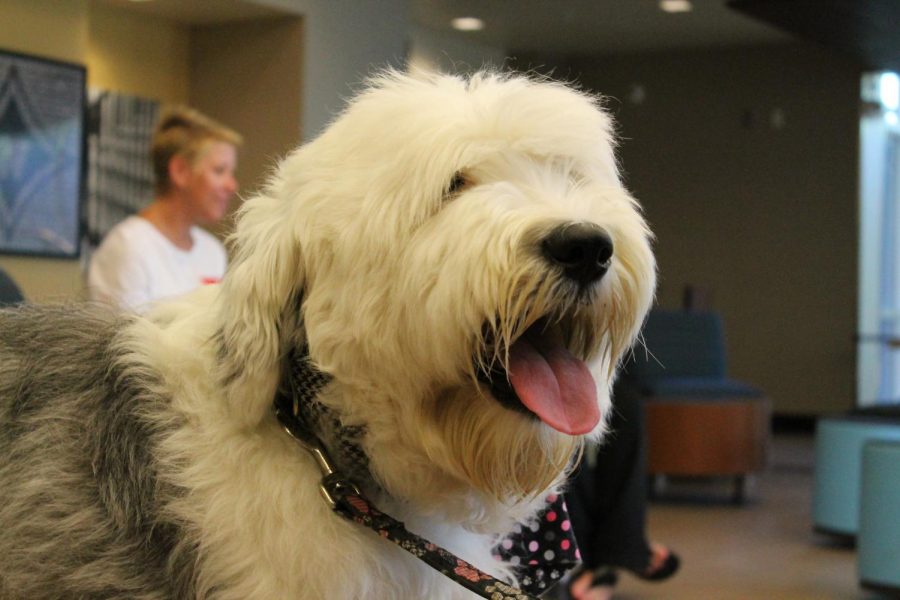Doggies Calm the Soul
May 18, 2018
The door opened to the Sweetgrass Cafe and five of the most calming, loving and furry pups came to greet the stressed AP students. Yogi the corgi flashed them a smile. Porkchop nuzzled his big hairy head into their laps.
And their stress was gone. They were on the floor, laughing and playing with the registered therapy dogs. Completely reverted back to their younger days when college credit was not the only thing swarming their minds.
AP Academy brought therapy dogs for students to hang out and destress before the long two weeks of final exams. Media specialist Erica Smith decided to expand her program “Paws for Literacy” to benefit more students especially during the busy month of May.
“The program actually stemmed out of another program I run here at Wando called ‘Paws for Therapy,’ and it basically uses the dogs to help our exceptional needs students with developing literacy and trying to learn how to read,” Smith said. “The dogs provide them with an environment that makes them happy. They want to come, and they want to read to the dogs which gives them a reason to try and work on their literacy.”
Remembering her first day at Wando, Smith saw a stressed AP student in the front office mentally breaking down and thought that she could integrate this program to help other students as well.
Smith worked with AP Academy’s Jason Brisini to provide students with the therapy dogs for exam time. They recruited volunteers to bring their registered therapy dogs to school, and ll the students had to do was sign liability waivers. On day of their exam, the 180 students that signed up could come in, relax and distract themselves from anything school related.
The dogs were available everyday on testing days from 7 a.m. – 8 a.m. and 11 a.m. -12 p.m. in the second floor of the Sweetgrass Cafe for the students testing on that specific day.
“I think it’s kind of a distraction from school for just a minute. Sometimes distractions are good. Not prolonged distractions but at least small ones,” Brisini said.
Smith recognized that it can be hard for dedicated students to take a step away from what they have preoccupied their minds with. For as much as students do these days, Erica said, stopping and breathing is just as important.
“Just being here. Not thinking, not studying, not doing anything related to school. They just need to be here, be like they are at home — relaxed, pet some dogs, have a good time — because when you’re as stressed out as you guys get, it’s not good because your brain will actually start shutting down the thinking process,” Smith said. “When you’re here, it just lets it go, and you’re happy and you’re feeling good, you are going to have a better test.”
Student and senior Emma Scott got to experience the dogs on the first day of exams.
“It has been so exciting. I’ve been super stressed all day and super worried just about exams this week,” Scott said as she pet Porkchop. “Just being able to come in and take my mind off everything has been super fun.”
Smith has seen this success in “Paws for Literacy,” and seeing it being applied throughout the school even for two weeks is hopeful for Smith. Both Smith and Brisini wish to eventually see therapy dogs being used on a daily basis for all students through the guidance department.
“In a perfect world, we could have them here everyday anyway, so people could visit before and after school,” Brisini said. “I think that would help out the overall happiness of the school.”
This new program for exam weeks was a success: the students cuddling and laughing with Yogi, Porkchop, Sophie, and Charlie letting all stress from there upcoming exams roll off their shoulders, Scott said.
“There is pure soul in each of these furry little bodies, and you know humans have a natural distrust of each other, I know that’s weird, but dogs don’t have that,” Smith said. “You can be completely open with a dog, and they will just look at you and smile. You can tell them the worst thing in the world, and they are still going to look at you and smile. I absolutely 100 percent believe that dogs have a different form of therapy all together than an actual person or therapist.”






